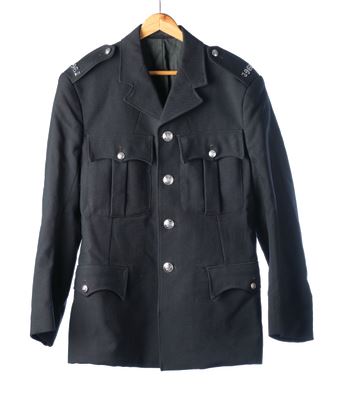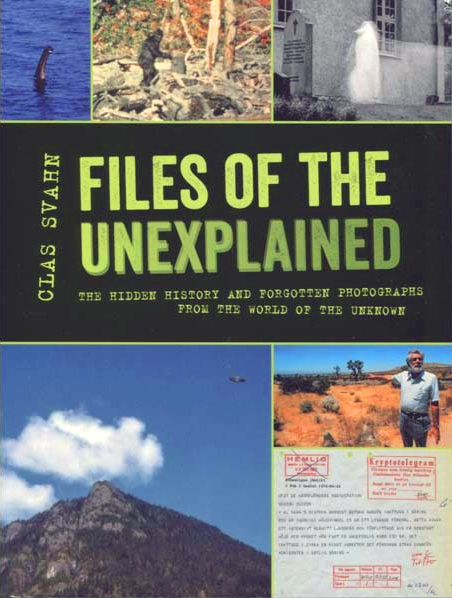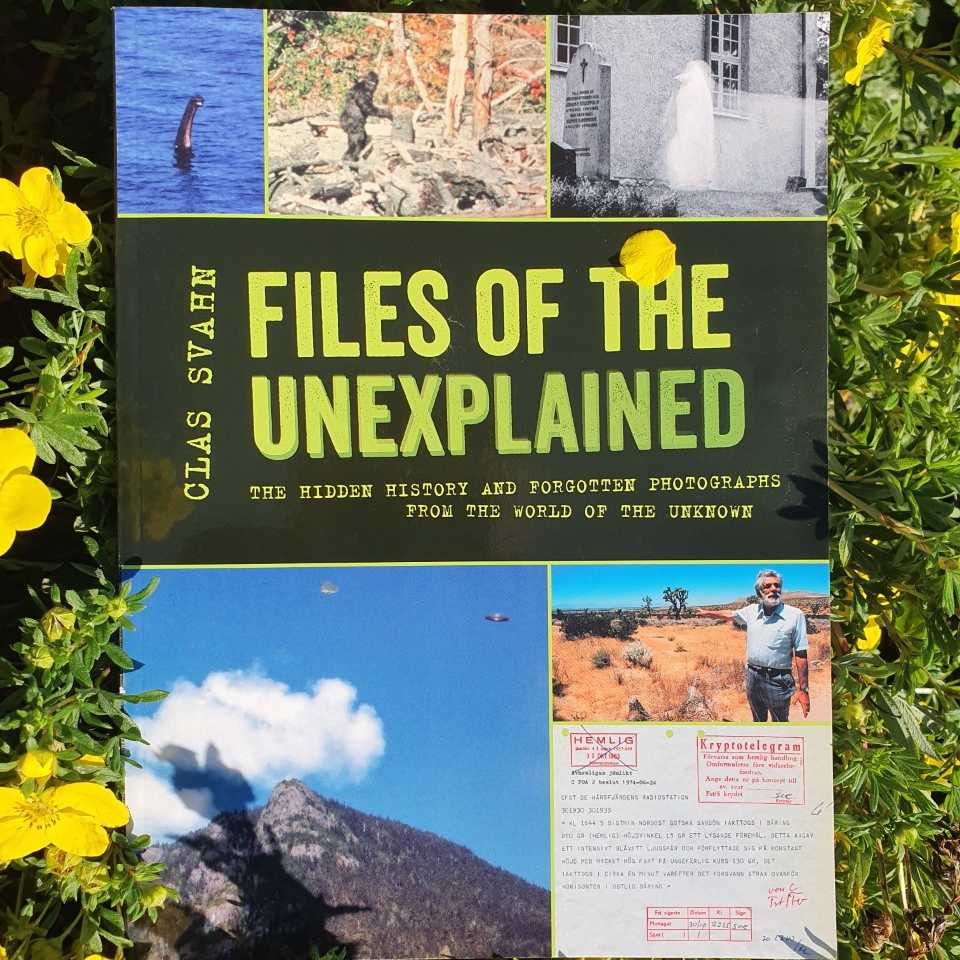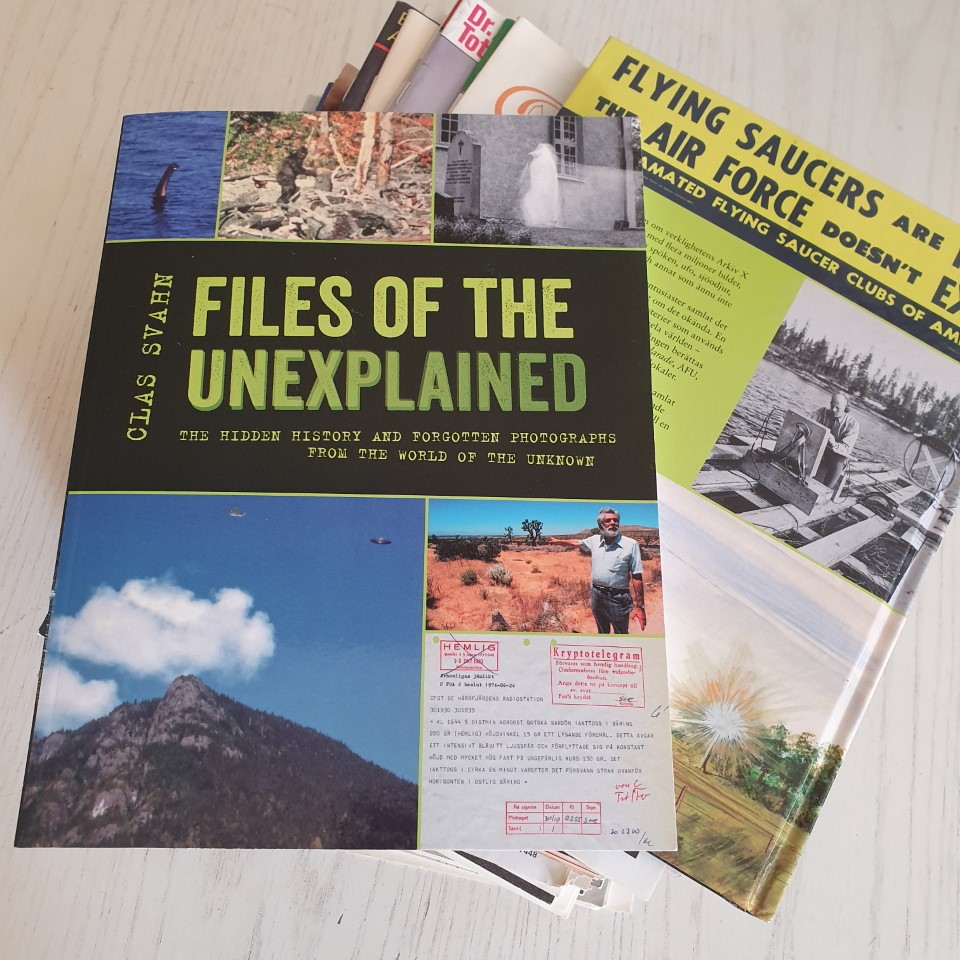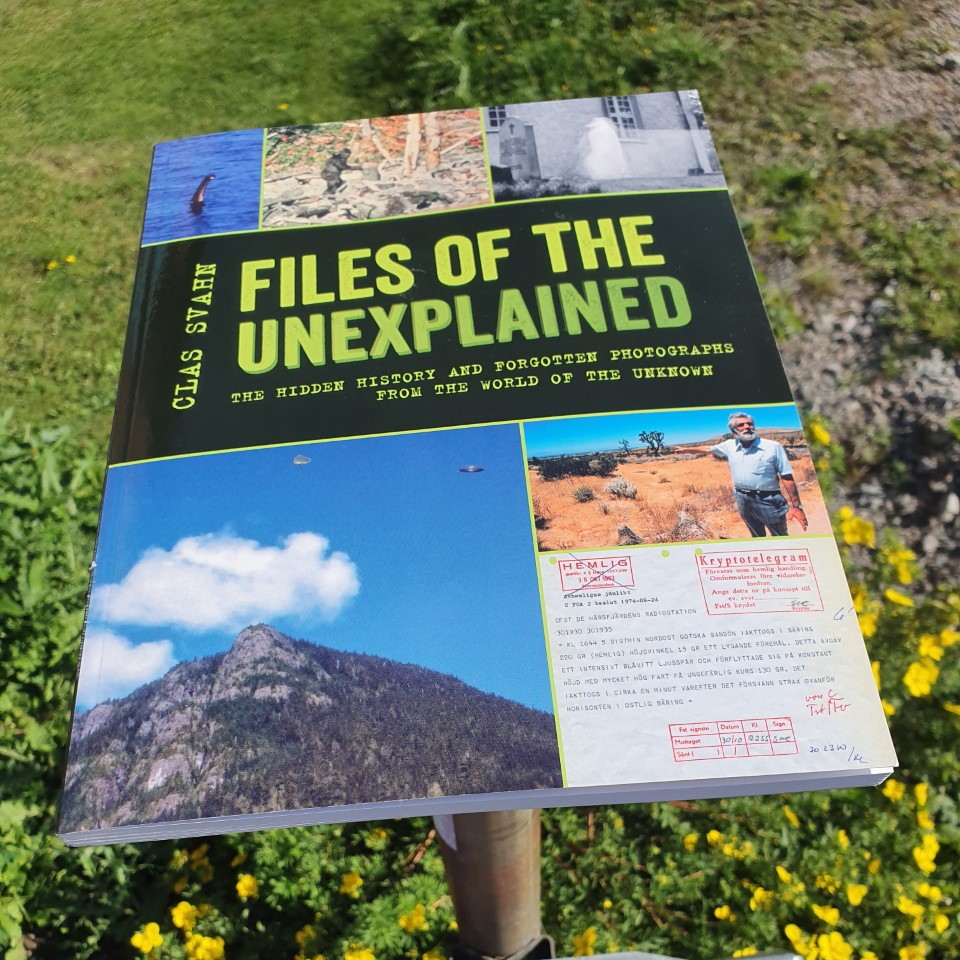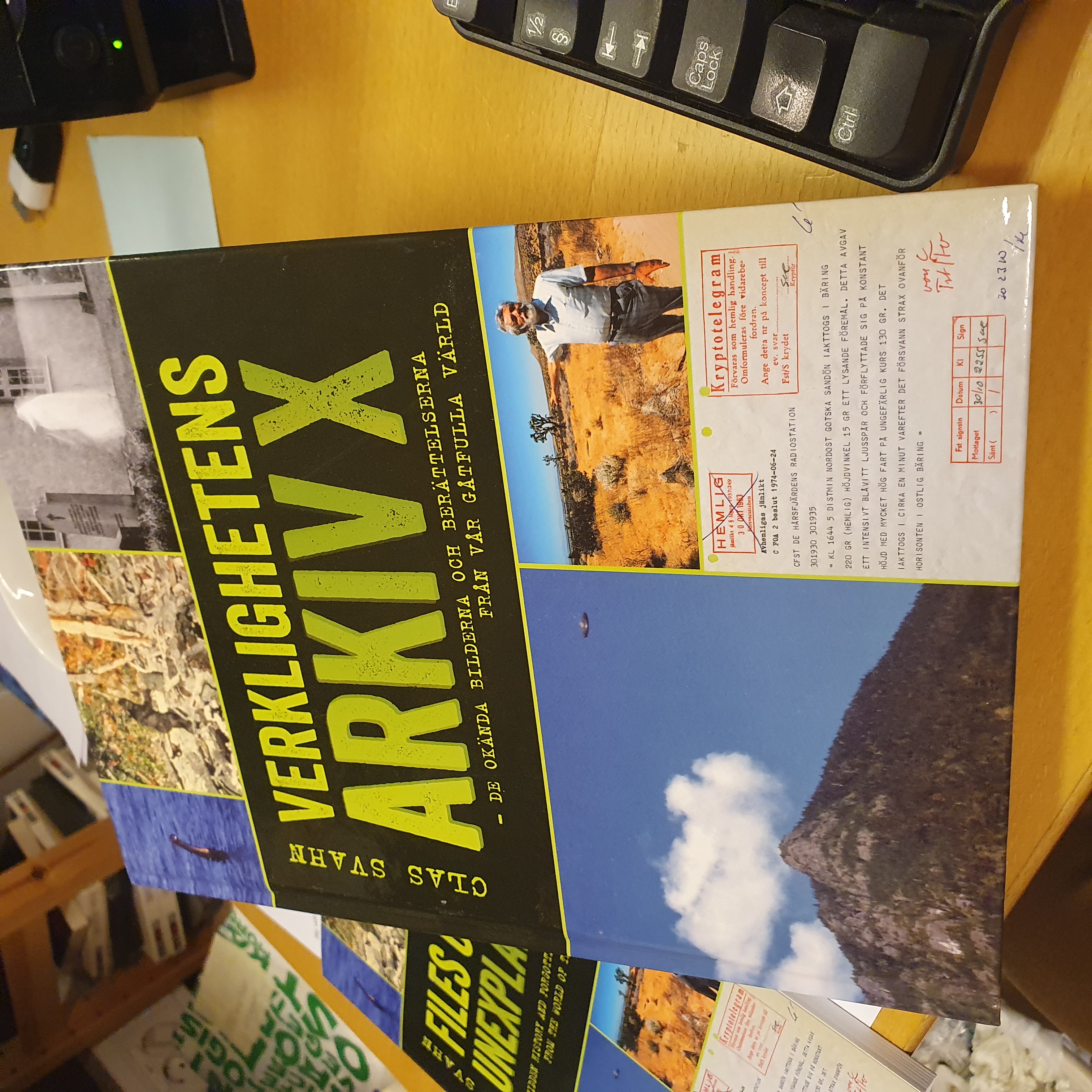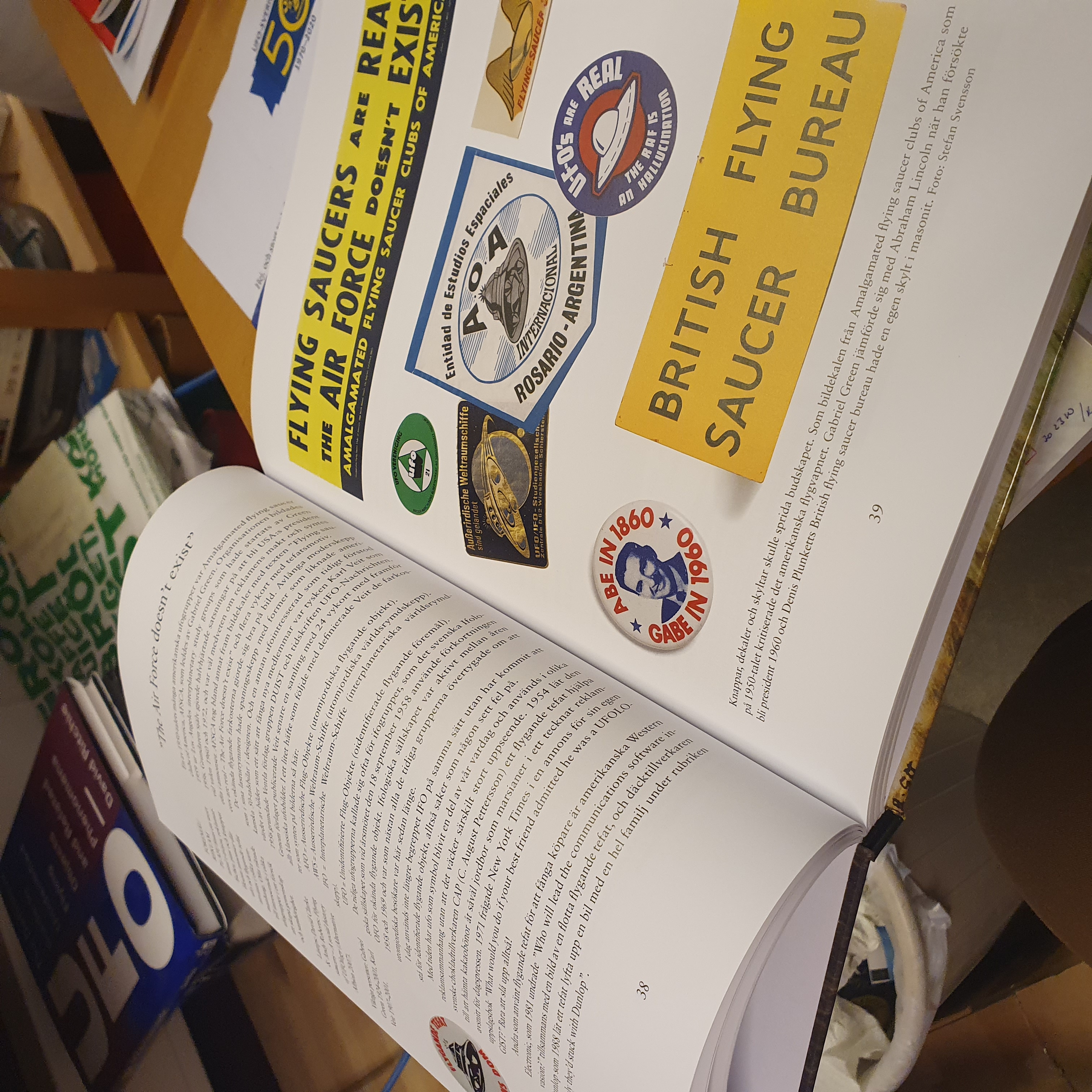The Real X-Files
There is a real X-Files and it is situated in Sweden. And it contains much of British UFO history.
I have spent my free time working for Archives for the unexplained (AFU) for nearly 40 years travelling to many countries with one aim: to save the history of the unknown, the history of UFOs and the people engaged in the research about them. And to do that before the files are lost for ever.
Which happens every so often. Files ends up in a dump and one person’s life time work vanish into oblivion.
Since 1973 AFU has saved the files of hundreds of ufologists and made them available to the world and today the files after the late editor of Flying Saucer Review Gordon Creighton (1908–2003) and the late American publisher and ufologist Wendelle Stevens (1923–2010) are among the many that are saved at AFU.
AFU board member Carl-Anton Mattsson in the large UFO library.

Today AFU is the largest and most comprehensive archive when it comes to the mysteries and unknowns in the world. Behind our doors is a unique treasure.
Tens of thousands of books, millions of documents and newspaper articles, thousands of pictures, movies and tape recordings, hundreds of posters, toys, stamps and perhaps as many as 50,000 UFO reports from a number of countries are gathered in fourteen rooms totalling 550 square meters (660 square yards).
The hundreds of shelves have been full for a long time. Every now and then we have to rent another room in the same area in order to store everything. What began with a bookshelf in Södertälje, just outside of Stockholm, in 1973 extends today over 1,8 miles (3 kilometers).
And every document has its story to tell.
AFU is an archive for the unknown. Here, gnomes, aliens and angels appear side by side with sea monsters, Bigfoot and animals that really should have been extinct long ago. Here are remarkable astronomical observations, rare phenomena in nature, reports of unidentified phenomena and craft in the air, on the ground and in the water.
In the acid-free cartons and on the shelves with binders and books there are stories and investigations that suggest that in many cases we have to deal with tangible physical phenomena. Phenomena that can leave their imprint on a picture, make a return on radar and make themselves heard on tape recordings.
Sometimes. Not often. But often enough to stir our curiosity.
Here the reader is met by stories of the unknown, hard-to-grasp experiences, mysteries and riddles that still lack their explanation. But also the explanations, the debunking and the beliefs.
There are other archives in countries like the US, Italy, Spain and Germany to name a few. But AFU is the only one that spans the whole world and collects everything from the most arrogant statements to the most elaborate scientific dissertations. Believers and critics, side by side. Topics like conspiracy theories and destructive cults could be found as magazines on astronomy and science and a unique collection of strange and extreme weather events put together by the late British meteorologist Dr Justin Schove (1913–1986).
All this strange and unbelievable data we gather under a designation that many may not be acquainted with but that defines the unknown without setting boundaries. We call it Fortean phenomena after the American Charles Hoy Fort (1874–1932) who wrote several books about a world he found strange and full of mysteries. And while Charles Fort gathered his knowledge on small index cards, AFU gathers everything in neat boxes on shelves purchased at Ikea.
A part of the paranormal library.

Many of the topics that are found at AFU today have caused heated debates and divided different groups into ‘believers’ and ‘skeptics’. This is often noticeable in the documents and correspondence left by different people. For example, the crop circle phenomenon, since Colin Andrews gave it that name in 1983, has made many believe that it is created by visiting aliens, who through these patterns in the cornfields, try to give us earthlings messages and warnings. Others say they are made by clever humans. AFU as an archive never takes sides in any of these debates but looks at all aspects of the issues. Today AFU keeps crop circle researcher Busty Taylor’s files and pictures as Paul Vigay’s and soon also Pat Delgado’s.
AFU was born in 1973 as the Arbetsgruppen för ufologi (The Working Group for Ufology). At the time it was more an idea than a finished archive. Behind the hope to build a lending library with Fortean literature stood three Swedes, Anders Liljegren, Håkan Blomqvist and Kjell Jonsson. Even though the collection was initially just a well-stocked bookshelf and wardrobe at the home of Kjell Jonsson, it expanded in the early 1980’s to more than 800 volumes and was moved from Södertälje to Norrköping. At the same time AFU changed from being a hobby project to the foundation Archive for UFO research.

There are many examples of research files lost.
At one point I arrived a few days late to save the books and papers of a member of UFO-Sweden. Everything had been sent for recycling, even though AFU had been promised to take care of them. Since this had happened on a Saturday and I got to know about it late on Sunday evening; but there was still hope.
Early Monday morning I took my car and drove to the recycling station to see what I could do. I have to admit that I wasn’t particularly hopeful. As soon as I arrived at the station I saw a large container on the edge of the recycling area which contained books, furniture, clothes and other things that would be taken care of by a large second-hand store in the Stockholm area. And trying to find what I was looking for proved to be difficult when boxes and bags were stacked in piles as far into the container as I could see. Also, it was not allowed to take things out from there, only to leave them.
But my hope increased when the second-hand shop truck appeared and parked next to the container. When I told the driver about the problem he understood my situation. As soon as he had loaded the lorry he asked me to follow his car to the store’s giant sorting central at the other end of Stockholm.
An old paranormal magazine now at AFU.

Getting into the big sorting hall was like opening the door to the warehouse in the Indiana Jones movie Raiders of the lost Ark. There were boxes and steel cages with bags and banana cartons as far as I could see. After securing permission from a manager to break the rules that they otherwise kept strictly – no outsiders were allowed to come in and look – I started to go through the boxes delivered by the lorry. And an hour later I had found the man’s books and papers and could return home with several boxes that I could then deliver to AFU.
Anders Liljegren and Håkan Blomqvist were involved in something even more nerve-wracking when at the end of August 1989, they visited a relative of Sweden’s best-known and productive ufologist, K. Gösta Rehn (1891–1989) to retrieve his archive. Rehn had previously donated part of his book collection to AFU. As Gösta Rehn had for many years been in contact with a large number of UFO witnesses and ufologists, throughout the world, Liljegren and Blomqvist had great hopes of now also being able to save a unique material with correspondence and investigations.
To their great surprise, they were met by a modest pile of books. Not a piece of paper, not a letter. When the two asked what had happened to the rest of the files, they were told that it had been thrown into a garbage container at the back of the house a few weeks ago. With their hearts in their mouths they walked towards the container. To their great delight, they found the 32 binders with invaluable research reports and correspondence with other ufologists in many countries. A few days later and everything would have ended up at the dump.
British police officer Alan Godfrey’s jacket is now at AFU.
What is currently on the shelves at AFU is the result of hundreds of people gathering and saving over the years. Individuals, small groups and larger organizations. In many cases items were donated, in other cases, rescued from damp basements, dusty winds or containers as in the stories I just told. What is worthless paper for some is for us historical documentation that many times cannot ever be replaced. But we also keep objects like policeman Alan Godfrey’s police jacket that he wore the eventful night in 1980 as a encountered a hovering craft over a road in Todmorden. And maybe was taken aboard.
We also keep objects found in connection with close encounters, others that have fallen from the sky, detectors made to send an alarm when a UFO passes over head and many other strange and interesting things that we hope to build a museum from.
But much is papers and information.
Alan Godfrey’s drawing of the object he met on a road in Todmorden in 1980.

During the second half of the 1980’s, AFU began actively copying the Swedish Armed Forces’ UFO reports. At that time I worked at a newspaper in the far north of Sweden and got the unique opportunity to borrow all the binders with UFO reports from the Swedish Defence Research Institute, FOA (which has now been merged with the Swedish Defence Forces Research Institute, FOI). I packed them in bags at FOA outside Stockholm to bring them on the flight to Luleå to copy them.
The worn binders proved to be a pure gold mine providing a unique insight into how the Swedish Armed Forces devoted time and resources to collecting and investigating reports of unidentified flying objects all across Sweden. Something that started with the investigation of the two waves of ‘Ghost Flyers’ in the 1930s, which was followed up by the Swedish Defence Forces’ aviation and air defence department’s own Ghost Rockets investigation in 1946. A task which, from 1965, was managed by FOA and then for a shorter time by FOI.
On June 13, 2011, AFU was able to receive the entire FOI archive when the then UFO officer Eva Bernhardsdotter and archive manager Steve Olsson handed over the 6,562 documents in their UFO file on a hard drive containing a total of 76 gigabytes of reports from 1946 to 2009. Later further binders were scanned for AFU before the unique archive was transferred to the Swedish War Archives.
Of those two early UFO waves, the Ghost Rockets have caught the interest of many as they were seen by thousands of Swedes – also in Norway and Finland and to a certain extent in Denmark – and became the subject of an extensive investigation by the Swedish military. And even though the defence at that time directed its suspicions against Russia, no evidence was found that those mysterious objects originated from there.
Many of the Ghost Rockets also plunged into lakes, which should have revealed their origin (if found), while others were hunted by at least one Swedish pilot. But the lakes turned out to be empty – only indentations in the bottom could be found – and the pilot could only see the Ghost Rocket leave him and his aircraft way behind when trying to intercept.
British ufologist and artist Dave Sankey’s drawing of a Swedish Ghost Rocket made specially for AFU.

Forty years later, the pilot, Gunnar Irholm, related what he had seen when I called him after finding his report in the Swedish War Archives’ collections:
“It looked like a big and fat cigar, pointed front and back. There were no contours or shades of color or features that made it differ from a gray cigar. My reaction was that it couldn’t be a regular airplane. And we were close enough that I could decide whether it was an airplane or not. The object was completely torpedo formed. But then it disappeared. In a very short time, it disappeared from view. Unfortunately.”
The Swedish Defence Reports are only part of the many military inquiries that have found their way to AFU. The archive also contains copies of the British Defence investigations, although much had been burned before researcher Dr David Clarke, in Sheffield, managed to save what remained from being destroyed. A large number of boxes of microfilms from the American Air Force’s ambitious and extensive investigation work are also on an AFU shelf. That inquiry called Blue Book, began as early as 1947 and came to include 12,618 observations before the project was closed in 1969. This was after an investigation by the Colorado University stated that it could hardly benefit science to study UFOs and that the federal government should not continue to handle the public’s observations.
The author with one of the Blue Book microfilms.

However, anyone who takes the time to study the material on the microfilms, is struck by how many well-studied but still unidentified observations are hidden there. In one of the cases – also reproduced in the nearly 1,000 pages of the Colorado University’s study – is an event from the winter of 1967, in which a woman in a car was traveling along a road in Ohio. Suddenly the woman discovered that a large area in front of her was illuminated by an unknown source of light.
The observation was made at 2 AM at night. There were no other light sources nearby, so when she herself shut off the car’s headlights – to see if there could be anything wrong with them – she expected the road to become completely dark. It wasn’t.
Instead, she realized that the light that still appeared on the road came from an object hanging in the air above her car. Worried, she again turned on the lights and continued driving along the road when she noticed that the accelerator pedal no longer responded when she tried to increase speed.
After ten to fifteen minutes, when the woman was on her way up a small hill, she saw how the object quickly departed. Now she could also see the shape of what she later describes as a sponge turned upside-down with a yellow glow and with several larger and smaller lights on the hull.
The investigators designated the event as “unexplained”.
At the end of the Blue Book project, there were still 701 reports that were never explained among the thousands of cases that had reached the US Air Force.
A similar analysis was ordered by the British defence who on a regular basis from 1967 to 2000 sent all UFO reports to a department called DI55 within the Defence Intelligence Service, whose primary task was to work with space weapons. But this investigation, which came under the codename ‘Condign’, had another purpose – to ensure that the British defence force would no longer have to worry about dealing with UFO reports from the public.
In the previously classified report the anonymous investigator, who gained access to the whole British defence UFO files, notes that there is no evidence that unidentified flying objects observed in British airspace “are incursions by air objects of any intelligent (extra-terrestrial or foreign) origin, or that they represent any hostile intent”. All documents are saved as copies at AFU.
The report’s final recommendation was also the one that the British defence had hoped for: “It should no longer be a requirement for DI55 to monitor UAP reports as they do not demonstrably provide information useful for Defence Intelligence.”
UAP is here to be understood as ‘Unidentified Aerial Phenomena’, a term that is often used by the military of several countrys, because the abbreviation ’UFO’ has increasingly come to be confused with visitors from other planets.
But the UFO enigma itself was not solved by the mysterious person behind the Condign report. At the beginning of his 465-page report, he quotes former British Prime Minister Winston Churchill, who on July 28, 1952 wrote a famous minute to the secretary of state for air, Lord Cherwell:
“What does all this stuff about flying saucers amount to? What can it mean? What is the truth? Let me have a report at your convenience.”
58 years later the anonymous man behind the Condign report answers Churchill’s question in his summary: “The topic of Unidentified Aerial Phenomena (UAP) has remained an enigma since well before the Prime Minister’s remarks above. Since earliest recorded history probably only two key factors have changed – there are now more UAP reported, and there are also more objects in the sky which can be misreported.”
Although much of the material at AFU is in English, there are also large collections in a number of other languages. Of course Swedish is used by the large number of individuals’ and organizations’ archives that AFU has saved. But there are also reports and documents in Norwegian, Danish, Finnish, Russian, German, French, Japanese and a wide range of other languages. One of the single largest archives arrived in 93 boxes from Spain, in the summer of 2013, when Centro de Estudio’s Interplanetario’s collection of 50 years of activity, reached Norrköping through the organization’s chairman Martí Fló.
X-Files got its own label in the library system that makes finding a book easy.

Another large archive comes from British UFO Research Association (BUFORA), which was founded in 1964 but which, despite many members and a long line of active investigators, never came to build its own archive. Instead, many of the reports were distributed to the various investigators – where they remained. Instead, it would be AFU that, after twenty years of traveling around the UK, managed to collect most of the British UFO history from Newcastle in the northeast to Truro in the southwest. When BUFORA celebrated its 50 years anniversary with lectures and information for the public in central London, I could hand over a hard drive with all the reports, magazines, recorded lectures and films that we had saved so far. Everything scanned by the staff at AFU.
A large number of British UFO reports have been preserved at AFU, some of them from BUFORA, others from Contact International and magazines such as Flying Saucer Review, which for decades was the world’s most influential UFO magazine, presenting observations of unidentified objects from all around the world. Between 1982 and 2003, it was published under the editorship of the eccentric but savvy Gordon Creighton. FSR, as it is often known as, has been around since January 1955 and today the first issues are collectibles and very difficult to obtain.
Creighton became part of the British diplomatic corps in 1932, working as a British consul in Shanghai, Chungking, New Orleans, Paris, Antwerp and Recife in Brazil. This suited him well because he spoke or read about twenty languages, including Chinese, Russian and Sanskrit. Gordon Creighton lived and worked in China for ten years between 1931 and 1941.
When Gordon Creighton passed away, Håkan Ekstrand and I became the first outsiders to enter his big house on 16 Cedars Avenue in Rickmansworth outside London. Gordon Creighton’s son Philip, who then lived in Preston, had lent us the key, asking us to stay downstairs. Something that made us immediately take the stairs up to the second floor.
When we tried to open the big door to a room facing the back garden, we found that it was stuck. Squeezing it slightly ajar, could see a floor cluttered with paper and stuff as if a small avalanche had occurred.
After a lot of pushing, we finally managed to squeeze in and were then met by a sight that almost took our breath away. Here, scattered in stacks and piles, were fifty years of documents, books and magazines from Creighton’s time as editor of Flying Saucer Review. Everything was mixed with advertising, old newspapers and clean debris.
A steel cabinet at the other end of the room turned out to contain the oldest material. After a while we realized that the heap of books that we, at first, did not pay much attention to actually hid a staircase, which when we cleared it, led up to another floor which in itself proved to contain a library of several thousand volumes. In the garden, a shed was filled with boxes with more files, but in better order.
In 2013, after ten years of negotiations, AFU finally managed to take care of the fantastic material that has now been sorted into acid-free covers, marked up and become possible to research. Between 2003 and 2013 the files were stored in a garage in Rickmansworth, then rescued to waterproof plastic boxes by Edwin Joyce, who took over the editorship of Flying Saucer Review after Gordon Creighton’s death and who still publishes FSR.
Not all archives have had the same luck.
Francis Copeland and Geoff Ambler with the files of Contact International.

In early 2010, I became aware that one of Britain’s oldest UFO groups was still active and still publishing a magazine – Awareness. In a friendly email to the chairman, Fran Copeland, I told her about AFU and our mission and soon we decided to meet. It turned out that Fran was a wonder of accuracy and that all the papers and reports were neatly placed in typically British document collectors in her and her husband Alan’s warm basement. After a couple of visits, AFU had borrowed and scanned the entire material, which was then returned to Contact International.
But we also found out that this was not all. Elsewhere in southern England we found more traces of the once very large archive that Contact International built. The organization was founded by Brinsley Le Pour Trench (1911–1995), the eighth earl of Clancarty, who for many years had the archive at his home. When he left, his relatives announced that the house would be emptied and that it relocation was urgent. One of the members, Geoff Ambler, hurried there by car.
“But I could only take as much as was held in the car, then I had to go. I didn’t know what happened to the rest, Geoff told me a few years ago.”
We also learned how further unique material was destroyed by a fire in a home. The man who took care of it had to jump from the second floor to save his own life.
What we did save at Fran’s and Alan’s basement was perhaps just the tip of an iceberg.
UFO and other Fortean reports reach AFU along many different paths and through many different sources. When my Russian-speaking colleague Stefan Roslund and I travelled to Moscow, in early October 1993, to meet a number of Russian ufologists, we had the hope of also digging deep into Russian archives. The visit became more exciting than we had imagined. When we had installed ourselves with our host family, all television broadcasts had gone off the air with only one channel still showing old Russian movies in black and white.
Later, we learned that military tanks rolled in along the Leningradskij Prospekt just minutes after we travelled that road on our way from the airport. In the next few days there was gunfire and we could both see how the tanks, bit by bit, hit the previously beautiful white parliament building in central Moscow. The building had been occupied by old communists and nationalists.
Despite the battles in the capital, we managed to make several important contacts and also receive a copy of the KGB’s unknown UFO archive. The copy came from the founder of Russia’s only official UFO group, Vladimir Zamoroka, who also arranged a meeting between us with Marina Popovich in Star City outside Moscow. But we also meet the authors Alexander Avschalumov, Rem Varlamov, Anatoly Listratov, German Arutiunov and Boris Sjurinov as well as Vladimir Musinsky who brought with him a suitcase packed with over 1,100 handwritten UFO reports. He had travelled from Yaroslavl, 186 miles (300 kilometers) north of Moscow, to hand them over to AFU.
Since AFU received the copies of the KGB material, we have translated them into English and when we compare the reports from the then Russian civil intelligence service – and the material in Musinsky’s bag – with reports from other parts of the world, we soon saw that they hardly differ in any important way.
The KGB documents were originally released to former cosmonaut Pavel Popovitch, who was for a time president for the Sojuz UFO centre. In a cover letter, it is pointed out that the KGB was not concerned with ”systematically collecting and analyzing information about abnormal phenomena (so-called unidentified flying objects)”, but sometimes got reports from organizations and private individuals who had observed such phenomena.
One of the cases found among the 124 pages, occurred at midnight on February 3, 1985, when several guards at a military weapons store in Gusen saw a globe flying at approximately 25 to 30 meters over the ground in different directions, back and forth across a warehouse area. The guard posts estimated the size of the green globe to be between 10 and 20 centimeters in diameter. When the object left the fenced area, several of the guards noticed that it split into a larger and a smaller globe. The smaller fell to the ground and went black. The larger one continued its journey until it disappeared from sight.
Despite the large amount of observations saved at AFU, we know today that most observers never tell what they have seen to anyone outside their own family or the closest circle of acquaintances. When the national organization UFO-Sweden, for several years and in different places in Sweden, knocked on the doors of 1,600 randomly selected persons, it turned out that 10 per cent of these had made their own observations of something in the sky they could not explain. If we convert that figure to the whole of Sweden’s population, this would mean that one million Swedes have seen phenomena that they have not understood. Of these, about 25,000 reported their observations to any UFO group or authority.
It is not just reports and documents that AFU saves for posterity. The extensive library today consists of more than 55,000 volumes in 34 languages.
Two of the archives’ largest book collections come from the UK, which is not so strange considering that British ufologists were some of the first to organizing themselves and built their own libraries. One collection comes from the author and founder of the image archive Mary Evans Picture Library in London, Hilary Evans (1929–2011); and the other from Manchester Librarian Peter Rogerson (1951–2018). Both remarkable people who lived for and with their books and each so filled of knowledge that books could be written about them.
The first time I met Hilary he took me on a hike through the five-story house at 11 Granville Park in Lewisham, in southern London, where he and his wife Mary lived with their dogs. Almost every one of the twelve rooms were filled with bookshelves as well as the attic – and one of the bathrooms!
Hilary and Mary Evans in front of their picture archive.

Hilary Evans was well acquainted with AFU and had even visited us in 1996. Both of us had one goal in common: to collect knowledge and making it available. That became apparent when I visited the former town hall building, not far from their own home, which he and Mary converted into the Mary Evans Picture Library in 1964. Today, it houses at least 20 million images, but also has space for books, magazines and an extensive collection of old science fiction magazines. The couple’s home looked in many ways the same and wherever they travelled, they took the opportunity to expand both libraries.
Hilary Evans used to describe himself as a “not entirely convinced, not entirely sceptical person”, something that was clearly reflected in the books he wrote. His neutral but curious attitude is in many ways a raw model of AFU.
When Hilary ended up in a hospital, he decided to donate the entire library to AFU. In November 2010, UFO-Sweden’sAnders Persson and I visited him, we spent three full days packing and carrying to empty his house of books. There were hundreds of boxes. Hilary’s book collection contained books back from the 19th century, about fairies, visions and revelations or other things that at that time could be difficult to explain and mysterious. Books that in many cases cost several hundred dollars each to buy, unattainable for a small archive like AFU. Today the collection is displayed in a special room called the Evans Library.
The other great book donation also took several years to find its way to Sweden. But the story of how it ended up at AFU is quite different to the one you just read. It began with one of AFU’s good friends in southern London – the long time ufologist and editor of Magonia magazine John Rimmer – telling us that there was a man in Manchester who had a comprehensive book collection and who also kept himself updated by constantly reading new ones. Despite this John Rimmer only gave us a slim chance to even meet the man. Peter Rogerson, who lived in Urmston on the outskirts of Manchester, had planned to donate his books to the local library where he had worked. The meeting with Peter became a friendship that lasted for years and ended with him donating his entire collection of books to AFU. In the spring of 2018 he passed away, far too early, leaving also a monetary donation in his will.
AFU keeps a large amount of files, books and papers donated from British ufologists and Fortean researchers such as Janet and Colin Bord, Jenny Randles, John Hanson, David Sankey, Margaret Fry, John Rimmer, Steven Gerrard, David Clarke, Bob Rickard, Nigel Watson, Gunter Hofer, Edwin Joyce, Denis Plunkett, Lionel Beer, Philip Creighton, Fran Copeland, Geoff Ambler, Bill Foley, Matt Lyons, Bob Digby, Mike Hutchinson, Paul Fuller, Omar Fowler, Norman Oliver, Steve Gamble to name a few.
AFU’s oldest book is an edition of The Prophecies of Nostradamus from 1697
A large part of the work at the archive is to ensure that the collections are saved for the posterity, that they are made available to researchers and interested parties, and that AFU can continue to grow. This assumes that we can gradually afford to rent new premises. A never-ending task headed by Anders Liljegren who spends full work days at AFU Monday through Friday.
It is hardly surprising that the digitization of the archive has high priority and today hundreds of thousands of pages of articles on UFO, paranormal phenomena, sea monsters, crop circles, Atlantis, conspiracy theories and much, much more have been scanned and placed on two different storage units. But here are also thousands of recorded interviews with eyewitnesses and lectures as well as radio and television programs – many of them unique.
One of the many great donations of audio recordings came through the daughter of the departed American ufologist Bill Caulfield (1925–2007). Caulfield, in turn, had saved over 100 original reel-to-reel recordings from journalist John Otto (1929–1999), recordings made between 1954 and 1969. Here are voices from the first generation of contactees such as George Adamski (1891–1965), Truman Bethurum (1898–1969), Daniel Fry (1908–1992), George Hunt Williamson (1926–1986) and Howard Menger (1922–2009) who talk about their travels to other planets and encounters with space humans.
Some of the tapes are recordings of early ufologists such as American Riley Crabb (1912–1994) who describes probably the earliest UFO group in the world. The Borderland Sciences Research Associates he founded in 1946 are today known as the Borderland Sciences Research Foundation, BSRF.
Many years later, in June 2016, I was standing in a garage on the outskirts of Eureka, California. Together with my sons Niklas and Markus, we packed cardboard boxes under the supervision of James Borges, today responsible for the BSRF. James Borges had faithfully ensured that correspondence, printed matter and other papers from the organization had been saved when he himself had moved.
The arrangement was a ticking disaster, dust and mold fought for the space, and it was clear that no one had looked into steel cabinets and boxes for decades. But what was there was a treasure for those who run an archive and thanks to an American businessman, who paid for the transport, this archive has now found a place at AFU.
But most of our funds that helps to pay for rent and preserving, scanning and transportation comes from 30 Swedish ufologists who every month put aside between 5 and 100 Pounds for AFU. Now we are looking for people outside Sweden as well since this is an international archive and should engage people with an interest in unsolved mysteries. Next year AFU may be moving to larger premises, nearly twice the size of todays. Our plans are to find something that we can stay in for the foreseeable future, and to build a real museum.
To be able to do this we need twice as many donators every month. Anyone interested in donating material to AFU or to be a part of this fantastic archive, do not hesitate to contact the author of this article.
Clas Svahn (clas.svahn@gmail.com)
www.afu.se
Clas Svahn’s book about AFU ”Files of the unexplained
128 pages in large format and full color, could be bought from AFU-Shop where you also can find hundreds of other books and magazines for sale.
Every penny goes to support AFU.
All picture credits AFU
FILES OF THE UNEXPLAINED
Fantastic book about
ARCHIVES FOR THE UNEXPLAINED
ISBN: 978-91-519-2172-3
Filled whith information and lots of great pictures about the archives huge collections,
which are truly everything between the underworld secrets to the mysteries of heaven.
Order your copy by clicking the button below.
We ship worldwide and the price is only $ 16 plus shipping.
BUY NOW!
or contact Clas Svahn at clas.svahn[at]gmail.com
Order your copy now, you won´t regret it.
ISBN: 978-91-519-2172-3
Thank you very much for joining us and helping preserve -
Archives for the Unexplained
www.afu.se
VERKLIGHETENS ARKIV X
Fantastiskt bok om
Arkivet För det Oförklarade
ISBN: 978-91-552-6748-3
Fylld med massor av information och mängder med fantastiska bilder om arkivets samlingar,
som verkligen är allt mellan underjordens hemligheter och skyarnas mysterier.
Beställ redan nu genom att klicka på knappen nedan.
Boken blir din till det facila priset av endast 159 svenska kronor plus frakt.
KÖP NU!
eller så kan man kontakta författaren direkt på: clas.svahn[at]gmail.com
Files of the Unexplained - the English version.
ISBN: 978-91-519-2172-3

